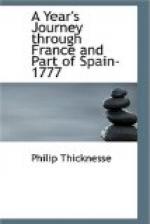“Profuse the myrtle
spread unfading boughs,
Expressive emblem of eternal
vows.”
For the myrtle, the eglantine, the jessamin, and all the smaller kind of aromatic shrubs and flowers, grew on all sides thick and spontaneously about us; and our feet brushed forth the sweets of the lavender, rosemary and thyme, till we arrived at the first, and peaceful hermitage of Saint Tiago. We took possession of the holy inhabitants little garden, and were charmed with the neatness, and humble simplicity, which in every part characterised the possessor. His little chapel, his fountain, his vine arbor, his stately cypress, and the walls of his cell, embraced on all sides with ever-greens, and adorned with flowers, rendered it, exclusive of its situation, wonderfully pleasing. His door, however, was fast, and all within was silent; but upon knocking, it was opened by the venerable inhabitant: he was cloathed in a brown cloth habit, his beard was very long, his face pale, his manners courteous; but he seemed rather too deeply engaged in the contemplation of the things of the next world, to lose much of his time with such things as us. We therefore, after peeping into his apartments, took his benediction, and he retired, leaving us all his worldly possessions, but his straw bed, his books, and his beads. This hermitage is confined between two pine heads, within very narrow bounds; but it is artfully fixed, and commands at noon day a most enchanting prospect to the East and to the North. Though it is upwards of two thousand three hundred paces from the convent, yet it hangs so directly over it, that the rocks convey not only the sound of the organ, and the voices of the monks singing in the choir, but you may hear men in common conversation from the piazza below.
This is a long letter; but I know you would not willingly have left me in the midst of danger, or before I was safe arrived at the first stage towards heaven, and seen one humble host on GOD’s high road.
P.S. At two o’clock, after midnight, these people rise, say mass, and continue the remainder of the night in prayer and contemplation. The hermits tell you, it was upon high mountains that God chose to manifest his will:—fundamenta ejus in montibus sanctis, say they;—they consider these rocks as symbols of their penitence, and mortifications; and their being so beautifully covered with fine flowers, odoriferous and rare plants, as emblems of the virtue and innocence of the religious inhabitants; or how else, say they, could such rocks produce spontaneously flowers in a desart, which surpass all that art and nature combined can do, in lower and more favourable soils? They may well think so; for human reason cannot account for the manner by which such enormous quantities of trees, fruits, and flowers are nourished, seemingly without soil. But that which established a church and convent on this mountain, was the story of a hermit who resided




